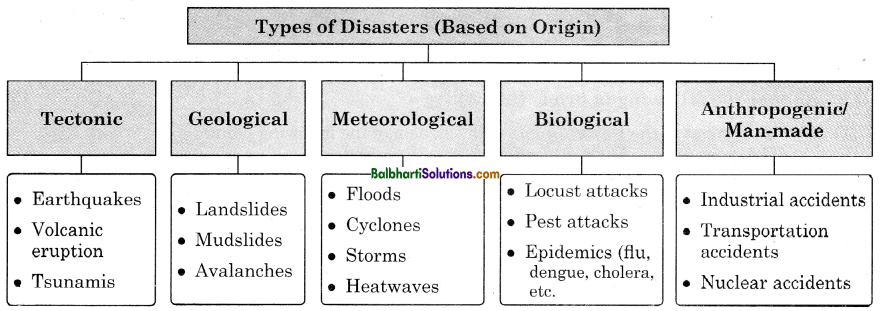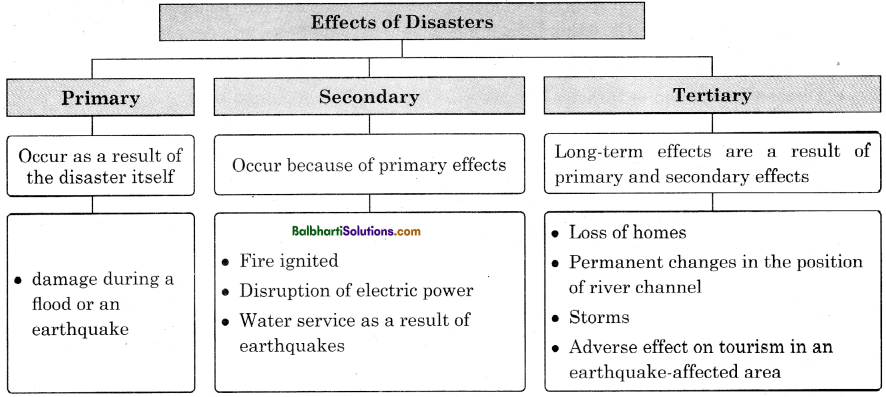By going through these Maharashtra State Board Class 11 Geography Notes Chapter 9 Disaster Management students can recall all the concepts quickly.
Maharashtra State Board Class 11 Geography Notes Chapter 9 Disaster Management
→ Natural disasters have caused widespread loss of life and property.
Types of Disasters (Based on Origin)
Tectonic:
- Earthquakes
- Volcanic
- eruption
- Tsunamis
Geological:
- Landslides
- Mudslides
- Avalanches
Meteorological:
- Floods
- Cyclones
- Storms
- Heatwaves
Biological:
- Locust attacks
- Pest attacks
- Epidemics (flu, dengue, cholera, etc.
Arthropogenic/Man-made
- Industrial accidents
- Transportation accidents
- Nuclear accidents

→ Natural events that occur in nature and cannot be prevented are called hazards. When they occur in areas inhabited by humans and cause damage, they are termed as disasters.
Hazards :
- Hazards are phenomena that pose a threat to people, structural or economic assets and which may cause a disaster.
- They could be either naturally occurring in the environment or man-made.
- A hazard becomes a disaster when it affects human population, settlements and their activities.
Vulnerability :
- The geographical conditions and circumstances of people or region that make them susceptible to a disaster is known as vulnerability. Hence, if we are better prepared, we can reduce the risk of getting affected by disaster.
- Population living in certain areas are exposed to particular disasters.
| Disaster | People/Areas affected |
| 1. Cyclone | People living in coastal areas are more likely to be affected than those in the interior. |
| 2. Earthquakes | People living in seismically active areas are prone to earthquakes. |
Also, social, economic and political conditions may make people less or more likely to be affected by disasters, in the same region.
Example :
- The poor are more likely to be affected by disasters.
- Old people and children easily become victims of disasters.
- Densely populated areas more likely to be affected than sparsely populated areas.
Capacity to Cope :
- The ability of people, organisations and systems, using available skills and resources, to face and
manage disasters is known as their capacity to cope. , - Vulnerability is reduced if capacity to cope with the disaster is high.
Effects of Disasters:
Effects of Disasters –
- Primary
- Secondary
- Tertiary
1. Primary
- Occur as a result of the disaster itself
damage during a flood or an earthquake
2. Secondary:
Occur because of primary effects
- Fire ignited
- Disruption of electric power
- Water service as a result of earthquake
3. Tertiary
Long term effects are a result of primary and secondary effects
- Loss of homes
- Permanent changes in the position of river channel
- Storms
- Adverse effect on tourism in an earthquake-affected area

Disaster Management:
Disaster Management Disasters:
1. Preventable
- Gas leakage
- Rail accident
2. Non-preventable
- Volcanic eruptions
- Tsunamis
- Earthquakes (effect can be reduced)
3. Predictable
- Cyclones
- Floods

Disaster Management involves the following processes –
- Creating awareness about disasters.
- Taking steps to reduce its effects
- Evaluating the damage caused by the disasters providing relief, food and medical aid in affected areas involve many people, organisations and processes.
Disaster Management Tasks:

Disaster management tries to :
- Reduce risk to damages or losses.
- Focus on the hazard that causes the disaster.
- Attempt to minimize the adverse impact of the disaster on communities.
- Involve co-ordination from governments, local self-governments, police, military and para¬military forces, NGOs, doctors, scientists, planners, volunteers, groups or communities.
Disaster Management Cycle :
- Disaster Prevention → Disaster Mitigation → Disaster Preparedness.
- Pre-disaster planning is the process of preparing in advance to face disasters in future.
Disaster Preparedness :
It involves measures taken to prepare for and reduce effect of disasters.
Disasters Preparedness:
- Carrying out awareness campaigns
- Strengthening of the weak structures
- Preparing plans for households
- Preparing plans at community level

Mitigation :
- Mitigation is any measure taken to minimize the impact of a disaster before it occurs is known.
- It refers to action taken against potential disasters.
- It is carried out for those disasters which cannot be prevented.
- It helps the people by creating safer communities and reducing loss of life and property.
Mitigation Measures:
- Community level disaster planning
- Public awareness and information campaigns
- Preparedness of hospitals
- Construction of houses away from hazardous areas.

Mitigation Efforsts:
Structural Efforts:
- Construction of river embankments
- Strengthening existing buildings
Non-structural Efforts:
- Areas training in disaster management
- Regulating land-use
- Public education

Disaster Response :
- It is the way the community responds to the disaster.
- It reflects the preparedness of the community.
- It is the immediate period after the disaster strikes.
- It is concerned with providing food and shelter to the disaster victims, restoring normal condition and providing financial support.
Recovery :
These steps involve measures taken to bring life back to normal in affected areas.
Recovery:
- Restoration of basics services and repair of physical, social and economic damages
- Cleaning of debris
- Rebuilding roads and bridges
- Providing sustained medical care for displaced human and animal population

Rehabilitation :
- It is the last phase of disaster management.
- It involves :
- Efforts taken to restore normalcy in the long term.
- Providing housing to the affected, taking important decisions regarding economy, agriculture, etc., which have been affected by disasters.
Role of Remote Sensing, GIS and GPS in Disaster Management:
Remote Sensing :
- Remote sensing is very effective in mapping disaster prone areas, particularly flood – affected areas.
- Microwave data – Provides information on flood-inundated areas.
- Remote sensing satellites monitor the path of a cyclone.
- It can provide ample time with warning for evacuation and preparedness in advance.
- Data obtained from meteorological satellites is used for cyclone tracking, intensity and landfall predictions and forecasting of extreme weather events.
- Data from earth observation satellites is used for monitoring disaster events and assessing
the damages. , - Communication satellites help to establish communication in remote and inaccessible areas.
Navigation satellites are used for providing location-based services.
GPS (Global Positioning System): It is an important tool.
GIS:
- It has emerged as an important methodological tool for effective planning, communication and training in the various stages of the disaster management cycle.
- Plays a vital role in determining the extent of hazards and disasters.
- These techniques help in making planning and policy very easy for implementation.
Disaster Management in India :
Need : India’s geo-climatic conditions and its high degree of socio-economic vulnerability makes it one of the most disaster-prone country in the world.
Steps taken to mitigate the damage potential of national disasters in future at the Government of India level, two institutes were set up in New Delhi.
- The National Institute of Disaster Management (NIDM)
- The National Disaster Management Authority (NDMA) has been established at the centre.
- SDMA has been established at the state level.
- District Authorities at District level.
- National Crisis Management Committee also functions at the centre.
- Ministry for Agriculture – For disasters like drought.
- Military forces, para-military forces such as Home Guard.
- ISRO, NRSC (National Remote Sensing Centre) also play an important role in disaster management.